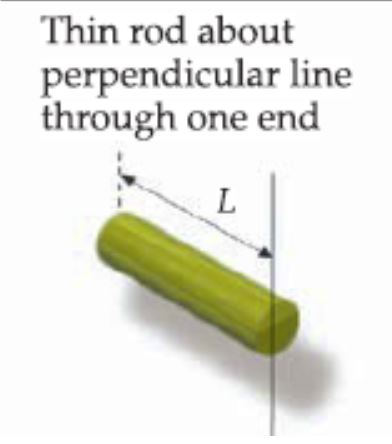
College Physics
11th Edition
ISBN: 9781305952300
Author: Raymond A. Serway, Chris Vuille
Publisher: Cengage Learning
expand_more
expand_more
format_list_bulleted
Question
A thing solid cylinder has a mass 6.98kg and a length 1.66 m. What is its moment of inertia (in unit of kg.m2) when it is rotating as shown above? (please search your physics text book or other sources for the correct formula for this situation, you lab manual does not necessarily have the formula.)

Transcribed Image Text:Thin rod about
perpendicular line
through one end
Expert Solution
This question has been solved!
Explore an expertly crafted, step-by-step solution for a thorough understanding of key concepts.
This is a popular solution
Trending nowThis is a popular solution!
Step by stepSolved in 2 steps with 2 images

Knowledge Booster
Learn more about
Need a deep-dive on the concept behind this application? Look no further. Learn more about this topic, physics and related others by exploring similar questions and additional content below.Similar questions
- A counterweight of mass m = 3.60 kg is attached to a light cord that is wound around a pulley as shown in the figure below. The pulley is a thin hoop of radius R = 7.00 cm and mass M = 3.00 kg. The spokes have negligible mass. (a) What is the net torque on the system about the axle of the pulley? V N.m to the right along the axis of rotation v magnitude 2.4695 direction (b) When the counterweight has a speed v, the pulley has an angular speed w = v/R. Determine the magnitude of the total angular momentum of the system about the axle of the pulley. (3.705 Note that your numerical answer is multiplied by the symbol v in the answer box. kg • m)v (c) Using your result from (b) and 7 = L/dt, calculate the acceleration of the counterweight. (Enter the magnitude of the acceleration.) 6.925 The expression for the angular momentum in part (b) has a factor of v. How do you determine dL/dt, from this expression? m/s2arrow_forwardStarting from rest, a 10.8cm diameter compact disk takes 7.96s to reach its operating rotational speed of 1920.0 rpm (revolutions per minute). Assume that the angular acceleration is constant. The disk's moment of inertia is 3.88E-5kg.m². How much torque is applied to the disk? Submit Answer Tries 0/10 How many revolutions does it make before reaching full speed? (Do not enter a unit.) Submit Answer Tries 0/10arrow_forwardA solid cylinder with mass m, radius R, and rotational inertia I (about its center) is released from rest and rolls down a ramp. Friction between the bottom of the cylinder and the ramp causes the cylinder to roll without slipping. The linear acceleration of the cylinder is a. Which TWO of the equations below are correct for this scenario? The equations are in terms of m, I, R, and a, as well as f (the force of static friction between the cylinder and the ramp) and g. (You must pick BOTH of them to get this question correct!) f = ma mg sin θ = ma mg sin θ - f = ma f R = I (a/R) mg sin θ - f = I (a/R) R mg sin θ = IaRarrow_forward
- A top has a moment of inertia of 10.7 kg-m2. The top is spinning at 41 rpm. How much rotational kinetic energy (in joules) does the top have?arrow_forwardFor each question, use degrees NOT radians. Healthcare professionals, when measuring range of motion (ROM) and isokinetic strength, use degrees - so this assignment will use answers in degrees as well. A person is laying on their stomach doing a hamstring curl. They go from fully extended (0o) to 130o of flexion. What is their angular displacement if the person is on their stomach with their head facing left (feet pointing right)?arrow_forwardA large grinding wheel in the shape of a solid cylinder of radius 0.330 m is free to rotate on a frictionless, vertical axle. A constant tangential force of 280 N applied to its edge causes the wheel to have an angular acceleration of 0.946 rad/s2. What is the moment of inertia of the wheel? What is the mass of the wheel? If the wheel starts from rest, what is its angular velocity after 5.40 s have elapsed, assuming the force is acting during that time?arrow_forward
arrow_back_ios
arrow_forward_ios
Recommended textbooks for you
 College PhysicsPhysicsISBN:9781305952300Author:Raymond A. Serway, Chris VuillePublisher:Cengage Learning
College PhysicsPhysicsISBN:9781305952300Author:Raymond A. Serway, Chris VuillePublisher:Cengage Learning University Physics (14th Edition)PhysicsISBN:9780133969290Author:Hugh D. Young, Roger A. FreedmanPublisher:PEARSON
University Physics (14th Edition)PhysicsISBN:9780133969290Author:Hugh D. Young, Roger A. FreedmanPublisher:PEARSON Introduction To Quantum MechanicsPhysicsISBN:9781107189638Author:Griffiths, David J., Schroeter, Darrell F.Publisher:Cambridge University Press
Introduction To Quantum MechanicsPhysicsISBN:9781107189638Author:Griffiths, David J., Schroeter, Darrell F.Publisher:Cambridge University Press Physics for Scientists and EngineersPhysicsISBN:9781337553278Author:Raymond A. Serway, John W. JewettPublisher:Cengage Learning
Physics for Scientists and EngineersPhysicsISBN:9781337553278Author:Raymond A. Serway, John W. JewettPublisher:Cengage Learning Lecture- Tutorials for Introductory AstronomyPhysicsISBN:9780321820464Author:Edward E. Prather, Tim P. Slater, Jeff P. Adams, Gina BrissendenPublisher:Addison-Wesley
Lecture- Tutorials for Introductory AstronomyPhysicsISBN:9780321820464Author:Edward E. Prather, Tim P. Slater, Jeff P. Adams, Gina BrissendenPublisher:Addison-Wesley College Physics: A Strategic Approach (4th Editio...PhysicsISBN:9780134609034Author:Randall D. Knight (Professor Emeritus), Brian Jones, Stuart FieldPublisher:PEARSON
College Physics: A Strategic Approach (4th Editio...PhysicsISBN:9780134609034Author:Randall D. Knight (Professor Emeritus), Brian Jones, Stuart FieldPublisher:PEARSON

College Physics
Physics
ISBN:9781305952300
Author:Raymond A. Serway, Chris Vuille
Publisher:Cengage Learning

University Physics (14th Edition)
Physics
ISBN:9780133969290
Author:Hugh D. Young, Roger A. Freedman
Publisher:PEARSON

Introduction To Quantum Mechanics
Physics
ISBN:9781107189638
Author:Griffiths, David J., Schroeter, Darrell F.
Publisher:Cambridge University Press

Physics for Scientists and Engineers
Physics
ISBN:9781337553278
Author:Raymond A. Serway, John W. Jewett
Publisher:Cengage Learning

Lecture- Tutorials for Introductory Astronomy
Physics
ISBN:9780321820464
Author:Edward E. Prather, Tim P. Slater, Jeff P. Adams, Gina Brissenden
Publisher:Addison-Wesley

College Physics: A Strategic Approach (4th Editio...
Physics
ISBN:9780134609034
Author:Randall D. Knight (Professor Emeritus), Brian Jones, Stuart Field
Publisher:PEARSON